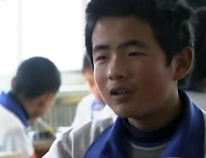Integrating rural schools for a better education

 0 Comment(s)
0 Comment(s) Print
Print E-mail CNTV, November 28, 2012
E-mail CNTV, November 28, 2012
At the recently closed 18th CPC National Congress, the need to improve education quality and promote equality, especially in the relatively poor western areas was emphasized.
In areas like northwest China's Gan Su province, education resources are very limited. But in recent years, many local schools have been integrated to pool together what limited resources they have.
15-year-old Lu Jianbin has been studying in the only middle school of his town for two years. The school provides accomdation 5 days a week to him, and he's pleased with the environment.
Lu Jianbin, student in Lanzhou No. 24 middle school, said, "I like studying here because the teachers are very good, and we have more PE equipments, better physics and chemistry experiment facilities."
There were once two middle schools in the town. Had they not been merged, Lu Jianbin would have been studying at the Wang Jiakou middle school, where students shared very limited space and poor teaching facilities. But he was lucky. Lanzhou No. 24 middle school absorbed Wang Jiakou middle school last year. It has now been turned to a primary school and kindergarten.
Dang Renfu, Headmaster of Lanzhou No.24 middle school, said, "Wang Jiakou middle school lacked basic teaching equipment and was short of teaching staff. So now that it's merged with our school, we can provide improved facilities and teachers, and students can have better education here."
Although this middle school is now shared by over 1000 students from the nearby 9 villages, they study in larger classrooms with better teaching equipment. According to Han Haiqing from the local education bureau, pooling together limited resources in rural areas, is a necessity.
Han Haiqing, Party Secretary of Education Bureau of Honggu Dist. , Lanzhou, said, "In Honggu district there were once 59 middle and primary schools. We have integrated these into 41 schools. Some schools in poverty stricken areas had very poor buildings and insuffient teaching equipment. And with falling number of students, some schools located in the mountain areas were short of young teachers. So during the past 3 years, we have spent 100 million yuan on integrating these schools."
With sufficient fund support, many music classes like accordion classes, have become part of the students' extra studies. They've been given more options to cultivate and broaden their interests.
During the past years, local students have benefited much from integrating limited education resources. With increased government support, they have enjoyed improved facilities, teachers and enviroment. This has made a difference especially in poor northwestern areas, where many young hopes are pinned on a better education, to a brighter future.






Go to Forum >>0 Comment(s)